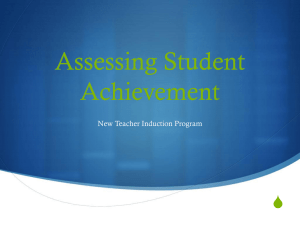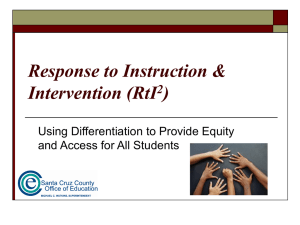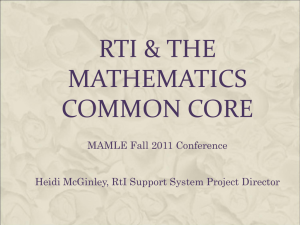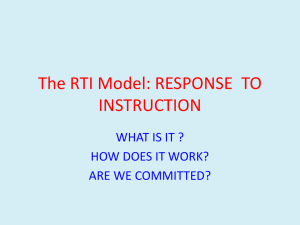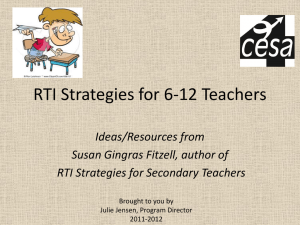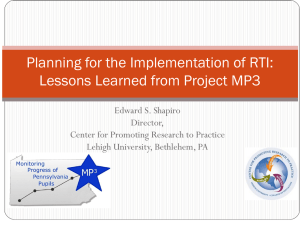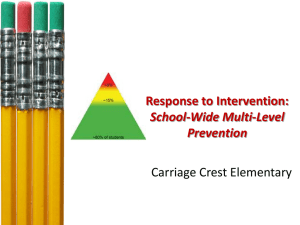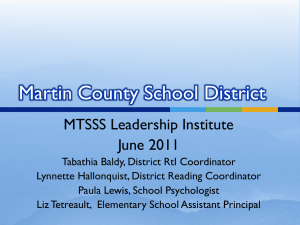TES Moving Beyond the Six Data Points
advertisement
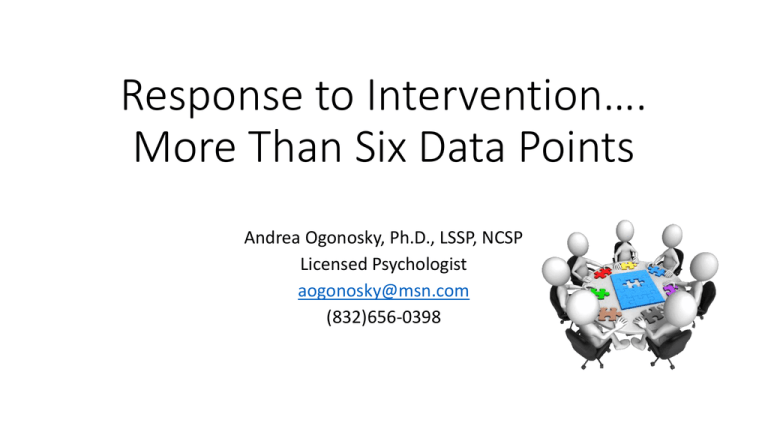
Response to Intervention…. More Than Six Data Points Andrea Ogonosky, Ph.D., LSSP, NCSP Licensed Psychologist aogonosky@msn.com (832)656-0398 Agenda • Technical Adequacy of Process • District Expectations • Multiple Sources of Data • Staff Knowledge • Leadership Technical Adequacy The District Guidance Document RtI: Problem Solving Assessment Progress Monitoring Diagnostics Progress Monitoring Diagnostics Universal Screening Progress Monitoring Interventions Student Instructional Level Supplemental Interventions 120 min per week additional Student Instructional Level Supplemental Interventions 90 min per week additional Grade Level Instruction/ Support The Reality of Striving for the Goal of Change… “I was so excited about RtI -I went about enthusiastically building a technically sound guidance document. As I began to work with staff on implementation [from the cultural perspective of shifting the way we think about problem solving] I realized suddenly that to me, RtI had become…. RtI One swirling VORTEX OF TERROR!” ---Dr. Quentin Woods, Pine Tree ISD Pair and Share • Have you ever felt like this? Why? • What has been your greatest challenge? On a scale of 1-5 where is your district as far as implementing a true problem solving process centered around Tier 1? Do you continue to hear staff refer to RtI as a referral process or a documentation journey on the road to special education? From the Student Perspective The Goal is to create… Academic Learning, Mastery, and Achievement Independent Learner RtI Foundations for Success 1. 2. 3. 4. Multiple Tiers of Instruction and Assessment Using Data: Balanced Assessments Technology Highly Qualified Staff The strongest processes that show sustained student growth are those that go beyond technical adequacy…. They are ones that promote a cultural responsiveness to the learning needs of all students (think Tier 1- 8-%)and are not dependent on a rote “decision rule” of six points on a graph. Let’s start at the beginning…. 10 RtI Is not simply implementing a different type of problem solving. It also involves giving up certain beliefs in favor of others. Systems will need to change…. Response to Intervention Is an organizational system with increasing layers of intensity. Is designed for smooth movement Not a categorical system for labeling students. Not a service or place. Increased intensity of Not a referral system for instruction -matches student special education eligibility. need -determined by data. Leadership The road to student success begins here…. Well versed in District RtI Philosophy Focused on Ongoing RtI Vision Strong Leader Uses ongoing evaluation of needs to drive resource allocation and professional development Critical Leadership in RtI Create a culture of common values and work together to achieve common goals. Provide clear staff expectations Ensure fidelity by having meaningful conversations with staff about data. Creatively allocate limited resources to ensure personnel have access to necessary supports. Essential Tasks for Leadership Team Use hybrid model of problem solving. Embed data based decisions across all systems Study and plan ongoing RtI development. Campus Culture Question who “If an educator keeps using the same strategies over and over and the student keeps failing, Who really is the slow learner?” Michael Rettig Professor, Emeritus James Madison University • Resiliency: Over 40% of teachers do not make it to their 5th year of teaching- many leave by year 3. • Encouragement of Innovation: PD to support advances in technology. Teachers reinforced and encouraged for “thinking outside the box”. • Quality of Student teacher relationships The use of technology makes ongoing data collection, data consumption, and data-based decision making a more plausible proposition, and it can keep these important aspects of RtI from monopolizing teacher time “The highest predictor of academic achievement is the proficiency of teachers in effective instructional practice.” Donna Walker Tileston Why Culture Counts The most important aspect of a strong RtI process is the richness of the conversations that occur because of the layers of multiple occurring data sources. It is essential to implement both Professional Learning Communities (PLC) and Response to Intervention (RTI) because these complementary processes are considered research-based best practices to improve student learning. Connections • What exactly do we expect all students to learn? • How will we know if they’ve learned it? • How will we respond when some students don’t learn it? • How will we respond when some students have already learned? • Core program • Standards • Alignment Documents Connections • What exactly do we expect all students to learn? • How will we know if they’ve learned it? • How will we respond when some students don’t learn it? • How will we respond when some students have already learned? • Progress monitoring • Universal screener • Diagnostic assessments • Formative Assessments Connections • What exactly do we expect all students to learn? • How will we know if they’ve learned it? • How will we respond when some students don’t learn it? • How will we respond when some students have already learned? • Differentiated Strategies • Interventions • Decision rules • Protocol Connections • What exactly do we expect all students to learn? • How will we know if they’ve learned it? • How will we respond when some students don’t learn it? • How will we respond when some students have already learned? • District Expectations • Decision rules • Protocol • PLC Essential Characteristics RTI Fundamental Elements • Focus on learning and collaborative culture • Collective responsibility and teaming • Focus on results (data driven) • Universal screening and progress monitoring • Systematic interventions and decision protocols • Research based core program and interventions • Action experimentation (is your system able to respond) • Collective inquiry Underscoring a Problem “Most teachers just do not possess the skills to collect data, draw meaningful conclusions, focus instruction, and appropriately follow up to assess results. That is not the set of skills we were hired to do.” 29 Balancing Assessments -- Assessment systems -- Multiple measures -- Varied types -- Varied purposes -- Varied data sets -- Balanced with needs Align Data Sources Universal Screening Progress Monitoring Diagnostic Assessments Outcome Assessments Does the data tell a clear and concise story of the student’s learning? If there is inconsistency team must investigate why Review integrity of instruction Align to student needs Student variables You must have multiple sources of data to have effective data-driven instruction. With that said, assessing students while they are learning yields real time data to steer teachers towards differentiated practices. Assessment and Instruction are inseparable. “Assessment is today’s means of understanding how to modify tomorrow’s instruction.” Carol Tomlinson Question Do your teams spend more time talking about individual kids or do they spend time more time on the needs of ALL kids? Team Philosophy • The 1st intervention is always effective classroom instruction and classroom management which yield high rates of academic engagement. • The team always uses the model of problem solving-consultationinstruction/intervention approach. Characteristics of a Strong Data Team Meeting Norms Process of Collecting Meaningful Data Culture of Collaboration Guaranteed and Viable Curriculum There is a process to measure where students are in the curriculum. There is a RtI plan in the school district to help students who are not achieving or who are excelling Problem Identification • Review existing information • Determine student’s functional level • Identify initial concerns • Analyze multiple data sources • Operationally define the problem Existing Data Review • Determine the Student’s Current Classroom Status: Academic Progress and Work Samples • Teacher Describes and quantifies concerns • Review of Records • Parent Contact(s) • Medical Information • Classroom Observations (ICEL) Determine Student Functional Levels • Identify assets and weaknesses • Identify Critical Life Events, Milestones, Circumstances (Positive and Negative) • Identify medical and/or physiological sources of concern • Identify academic variables such as “speed of acquisition” or retention of information • Identify issues of attendance, transitions, motivation, access to instruction Identify Initial Concerns • RtI team is available for any academic, behavioral, teacher or student concern. • Teacher reports concerns in a data oriented manner. • Team aligns concerns with data sources Supplemental Supports • Do your students show movement in the Tiers? • How long is too long? • Do you have students who are referred and then DNQ? What happens next? Do you have teams that are reluctant to move kids out of Tiers because they are successful? Monitor Fidelity Intervention Well Checks Observe in Tiers 1 and 2/3 Consult with Teacher Review data weekly in PLC/ Planning meetings Check data collection Talk to parent Tips for Moving Forward 1. 2. 3. 4. 5. Be aware of appeals to mindless precedent. Make sure the system of intervention is fluid. Systems of intervention work better when they are supporting teams rather than individual teachers. Realize that no support system will compensate for bad teaching. Ensure a common understanding of “system of interventions.” aogonosky@msn.com (832) 656-0398 I am happy to help you!
